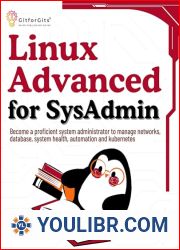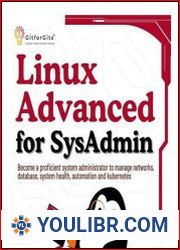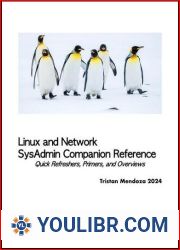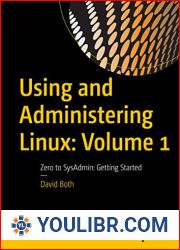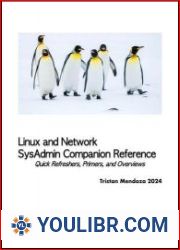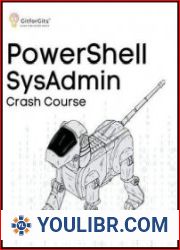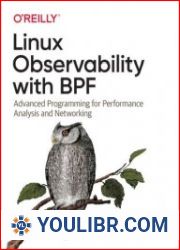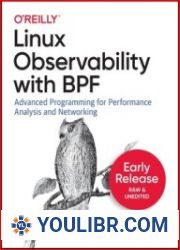
BOOKS - Linux Advanced for SysAdmin: Become a proficient system administrator to mana...

Linux Advanced for SysAdmin: Become a proficient system administrator to manage networks, database, system health, automation and kubernetes
Author: Ryan Juan
Year: May 31, 2024
Format: PDF
File size: PDF 1.2 MB
Language: English
Year: May 31, 2024
Format: PDF
File size: PDF 1.2 MB
Language: English
Building upon fundamental Linux skills, this book is designed to elevate your expertise to handle intricate tasks crucial for senior system administrators. To begin with, we will revisit key administrative tasks, providing a solid foundation for the advanced topics to come. This includes managing files, directories, packages, system services, and user permissions to ensure you're up to speed. We then dive into the critical aspects of network management, wherein we learn to configure network interfaces, manage IP addresses and routing, set up and secure network services like DHCP and DNS, and monitor network performance using tools such as Wireshark.We then move to explore iptables and firewalld, configure firewalls, implement AppArmor, and perform security audits with Lynis. The chapter also covers monitoring system logs for security breaches and using intrusion detection systems like Snort. Then, the chapter on Database Management demonstrates to work with databases in Linux, including installing and configuring PostgreSQL, designing databases, performing migrations, and securing database systems. This chapter equips you with the skills to manage database operations efficiently. The next chapter teaches you to monitor CPU and memory usage, track network performance, and analyze system logs using tools like Nagios and Zabbix. You will also learn to set up alerts and notifications to maintain optimal system performance.Later, we focus on automating routine tasks using shell scripting, cron, anacron, awk, and sed. You will learn to write scripts for system audits, resource management, and backup and recovery. Finally, the book covers large-scale deployments, Kubernetes, cluster management, load balancing, and kernel customization.Key LearningsGet the most out of AppArmor, firewalld, and iptables to boost up security.Take advantage of Nagios, Zabbix, and Wireshark to keep your systems and networks running smoothly.Get PostgreSQL up and running, migrate databases, and automate routine tasks; all while keeping databases secure.Resolve complex issues and maintain system health and uptime with troubleshooting skills.Optimize resource utilization, set up scalability, and ensure high availability by managing clusters.Improve your service's performance and dependability with sophisticated load balancing strategies.Personalize Linux's kernel in terms of speed, security, and hardware compatibility.Automate complex tasks with shell scripting, cron, and anacron.Table of ContentUp and Running with System Administration EssentialsManaging NetworksSecurity and MonitoringDatabase ManagementSystem Health MonitoringAutomation and ScriptingAdvanced System Administration
Linux Advanced for SysAdmin: Become a Proficient System Administrator to Manage Networks, Database Systems, Health Automation, and Kubernetes As technology continues to evolve at an unprecedented pace, it is essential for system administrators to stay ahead of the curve and develop a personal paradigm for perceiving the technological process of developing modern knowledge. This book, "Linux Advanced for SysAdmin," is designed to help senior system administrators elevate their expertise in handling intricate tasks crucial for managing networks, database systems, health automation, and Kubernetes clusters. The book begins by revisiting key administrative tasks, providing a solid foundation for advanced topics to come. These include managing files, directories, packages, system services, and user permissions. Network Management The next chapter focuses on critical aspects of network management, where you will learn to configure network interfaces, manage IP addresses, and routing, set up and secure network services like DHCP and DNS, and monitor network performance using tools such as Wireshark. You will also explore iptables and firewalld, configure firewalls, implement AppArmor, and perform security audits with Lynis. Additionally, you will learn how to monitor system logs for security breaches and use intrusion detection systems like Snort. Database Management The chapter on Database Management demonstrates how to work with databases in Linux, including installing and configuring PostgreSQL, designing databases, performing migrations, and securing database systems. This chapter equips you with the skills to manage database operations efficiently. Linux Advanced для SysAdmin: Станьте опытным системным администратором для управления сетями, системами баз данных, автоматизацией здравоохранения и Kubernetes Поскольку технология продолжает развиваться беспрецедентными темпами, системным администраторам важно оставаться на опережение и развивать личную парадигму для восприятия технологического процесса развития современных знаний. Эта книга «Linux Advanced for SysAdmin» призвана помочь старшим системным администраторам повысить свой опыт в решении сложных задач, критически важных для управления сетями, системами баз данных, автоматизацией здравоохранения и кластерами Kubernetes. Книга начинается с пересмотра ключевых административных задач, обеспечивая прочную основу для будущих продвинутых тем. К ним относятся управление файлами, каталогами, пакетами, системными службами и разрешениями пользователей. Управление сетью Следующая глава посвящена критическим аспектам управления сетью, где вы научитесь настраивать сетевые интерфейсы, управлять IP-адресами и маршрутизацией, настраивать и защищать сетевые сервисы, такие как DHCP и DNS, а также контролировать производительность сети с помощью таких инструментов, как Wireshark. Вы также изучите iptables и firewalld, настроите брандмауэры, внедрите AppArmor и проведете аудит безопасности с помощью Lynis. Кроме того, вы узнаете, как отслеживать системные журналы на предмет нарушений безопасности и использовать системы обнаружения вторжений, такие как Snort. Управление базами данных В главе, посвященной управлению базами данных, демонстрируется работа с базами данных в Linux, включая установку и настройку PostgreSQL, проектирование баз данных, выполнение миграций и обеспечение безопасности систем баз данных. В этой главе рассматриваются навыки эффективного управления операциями базы данных. pobierz plik pdf Linux Advanced dla SysAdmin Zostań doświadczonym administratorem systemu do zarządzania sieciami, bazami danych, zdrowiem systemu, automatyzacją i kubernetami 下载 pdf 文件 Linux Advanced for SysAdmin成為經驗豐富的系統管理員,負責管理網絡、數據庫、系統運行狀況、自動化和kubernetes
Scarica il file pdf Linux Advanced per il SysAdmin Diventa un amministratore di sistema esperto per la gestione di reti, database, funzionalità del sistema, automazione e kubernets скачать файл PDF Linux Advanced для SysAdmin Станьте опытным системным администратором для управления сетями, базами данных, работоспособностью системы, автоматизацией и kubernetes pdf dosyasını indir Linux Advanced for SysAdmin Ağları, veritabanlarını, sistem sağlığını, otomasyonu ve kubernetes'i yönetmek için deneyimli bir sistem yöneticisi olun PDFファイルをダウンロード Linux Advanced for SysAdminネットワーク、データベース、システムヘルス、オートメーション、kubernetesを管理するための経験豊富なシステム管理者になる تنزيل ملف pdf Linux Advanced for SysAdmin أصبح مديرًا متمرسًا للنظام لإدارة الشبكات وقواعد البيانات وصحة النظام والأتمتة و kubernetes להוריד קובץ PDF Linux Advanced for SysAdmin להיות מנהל מערכת מנוסה לניהול רשתות, מסדי נתונים, בריאות מערכת, אוטומציה וקוברנטות télécharger le fichier pdf Linux Advanced for SysAdmin Devenez un administrateur système expérimenté pour la gestion des réseaux, des bases de données, de l'état du système, de l'automatisation et de kubernetes PDF-Datei herunterladen Linux Advanced für SysAdmin Werden e ein erfahrener Systemadministrator für die Verwaltung von Netzwerken, Datenbanken, Systemintegrität, Automatisierung und Kubernetes download pdf file pdf 파일 다운로드 SysAdmin 용 Linux Advanced 네트워크, 데이터베이스, 시스템 상태, 자동화 및 kubernetes를 관리하기위한 숙련 된 시스템 관리자가 됨 descargar archivo pdf Linux Advanced for SysAdmin Conviértase en un administrador de sistemas experimentado para administrar redes, bases de datos, estado del sistema, automatización y kubernetes descarregar ficheiro pdf Linux Advanced para SysAdmin Torne-se um administrador de sistema experiente para gerenciar redes, bancos de dados, funcionamento, automação e kubernetes download pdf file Linux Advanced for SysAdmin: Become a proficient system administrator to manage networks, database, system health, automation and kubernetes
Questo libro, basato sulle competenze fondamentali di Linux, è progettato per migliorare la vostra esperienza nella gestione delle sfide critiche per gli amministratori di sistema senior. Per cominciare, torneremo alle sfide amministrative chiave, fornendo una base solida per i futuri temi avanzati. Questo include la gestione di file, directory, pacchetti, servizi di sistema e autorizzazioni personalizzate per garantire un'elevata velocità di funzionamento. Quindi approfondiamo gli aspetti critici della gestione della rete, dove impariamo a configurare le interfacce di rete, gestire indirizzi IP e routing, configurare e proteggere i servizi di rete come DHCP e DNS e controllare le prestazioni di rete con strumenti come Wireless-hark.Passiamo poi allo studio di iptables e firewald Configuriamo le schermate interforze, implementiamo le AppArmor e eseguiamo un controllo di sicurezza con Lynis. Il capitolo comprende anche il monitoraggio dei registri di sistema per le violazioni della sicurezza e l'utilizzo di sistemi di rilevamento delle intrusioni come Snort. Il capitolo sulla gestione dei database illustra quindi il funzionamento dei database in Linux, inclusa l'installazione e la configurazione dei database, la progettazione dei database, le migrazioni e la sicurezza dei sistemi di database. In questo capitolo vengono descritte le competenze per gestire in modo efficiente le operazioni del database. Nel capitolo seguente si impara a monitorare l'uso del processore e della memoria, monitorare le prestazioni della rete e analizzare i registri di sistema utilizzando strumenti come Nagios e Zagbix. Si impara anche a configurare avvisi e notifiche per garantire prestazioni ottimali del sistema. Successivamente ci concentreremo sull'automazione delle attività di routine con shell-script, cron, anacron, awk e sed. Si impara a scrivere script per il controllo del sistema, la gestione delle risorse e il backup e il ripristino. Infine, il libro include implementazioni su larga scala, Kubernets, gestione dei cluster, bilanciamento del carico e configurazione del kernel. Conclusioni chiave Approfittate di tutti i vantaggi di AppArmor, firewalld e iptable per migliorare la sicurezza. I vantaggi di Nagios, Zabbix e Wireshark per garantire la continuità operativa dei sistemi e delle reti. Avviare i database, migrare i database e automatizzare le attività di routine. con la protezione dei database. Risolvere i problemi complessi e mantenere il sistema operativo e i tempi di inattività con la risoluzione dei problemi. Ottimizzazione dell'utilizzo delle risorse, configurazione della scalabilità e elevata disponibilità grazie alla gestione dei cluster. Migliorare le prestazioni e l'affidabilità dei propri servizi attraverso complesse strategie di bilanciamento del carico. Personalizzazione del kernel Linux in termini di velocità, sicurezza e compatibilità hardware. Automazione di attività complesse con script shell, cron e anacron. Таблица ContentUp и Running with System Administration EssentialsManaging NetworksSecurity and MonitoringDatabase ManagementSystem Health MonitoringAutomation and ScriptingAdvanced System Administration
Building upon fundamental Linux skills, this book is designed to elevate your expertise to handle intricate tasks crucial for senior system administrators. To begin with, we will revisit key administrative tasks, providing a solid foundation for the advanced topics to come. This includes managing files, directories, packages, system services, and user permissions to ensure you're up to speed. We then dive into the critical aspects of network management, wherein we learn to configure network interfaces, manage IP addresses and routing, set up and secure network services like DHCP and DNS, and monitor network performance using tools such as Wireshark.We then move to explore iptables and firewalld, configure firewalls, implement AppArmor, and perform security audits with Lynis. The chapter also covers monitoring system logs for security breaches and using intrusion detection systems like Snort. Then, the chapter on Database Management demonstrates to work with databases in Linux, including installing and configuring PostgreSQL, designing databases, performing migrations, and securing database systems. This chapter equips you with the skills to manage database operations efficiently. The next chapter teaches you to monitor CPU and memory usage, track network performance, and analyze system logs using tools like Nagios and Zabbix. You will also learn to set up alerts and notifications to maintain optimal system performance.Later, we focus on automating routine tasks using shell scripting, cron, anacron, awk, and sed. You will learn to write scripts for system audits, resource management, and backup and recovery. Finally, the book covers large-scale deployments, Kubernetes, cluster management, load balancing, and kernel customization.Key LearningsGet the most out of AppArmor, firewalld, and iptables to boost up security.Take advantage of Nagios, Zabbix, and Wireshark to keep your systems and networks running smoothly.Get PostgreSQL up and running, migrate databases, and automate routine tasks; all while keeping databases secure.Resolve complex issues and maintain system health and uptime with troubleshooting skills.Optimize resource utilization, set up scalability, and ensure high availability by managing clusters.Improve your service's performance and dependability with sophisticated load balancing strategies.Personalize Linux's kernel in terms of speed, security, and hardware compatibility.Automate complex tasks with shell scripting, cron, and anacron.Table of ContentUp and Running with System Administration EssentialsManaging NetworksSecurity and MonitoringDatabase ManagementSystem Health MonitoringAutomation and ScriptingAdvanced System Administration
Ce livre basé sur les compétences fondamentales de Linux est conçu pour améliorer votre expérience dans la résolution de problèmes complexes critiques pour les administrateurs système senior. Pour commencer, nous reviendrons sur les principaux défis administratifs en fournissant une base solide pour les futurs thèmes avancés. Cela inclut la gestion des fichiers, des répertoires, des paquets, des services système et des autorisations utilisateur afin d'assurer une grande rapidité de fonctionnement. Ensuite, nous examinons les aspects critiques de la gestion du réseau, où nous apprenons à configurer les interfaces réseau, à gérer les adresses IP et le routage, à configurer et à sécuriser les services réseau tels que DHCP et DNS, et à contrôler les performances du réseau à l'aide d'outils tels que Wireshark.Ensuite, nous passons à l'étude des iptables et firewalld, configurons les écrans inter-réseaux, implémentons appArmor et effectue un audit de sécurité avec Lynis. Le chapitre traite également de la surveillance des journaux de sécurité du système et de l'utilisation de systèmes de détection des intrusions tels que Snort. Ensuite, le chapitre sur la gestion des bases de données présente le travail avec les bases de données sous Linux, y compris l'installation et la configuration de PostgreSQL, la conception des bases de données, l'exécution des migrations et la sécurité des systèmes de bases de données. Ce chapitre traite des compétences nécessaires pour gérer efficacement les opérations de la base de données. Dans le chapitre suivant, vous apprendrez à surveiller l'utilisation du processeur et de la mémoire, à surveiller les performances du réseau et à analyser les journaux système à l'aide d'outils tels que Nagios et Zabbix. Vous apprendrez également à configurer les alertes et les notifications pour maintenir les performances optimales du système. Plus tard, nous nous concentrerons sur l'automatisation des tâches de routine avec le script shell, cron, anacron, awk et sed. Vous apprendrez à écrire des scripts pour l'audit du système, la gestion des ressources, ainsi que la sauvegarde et la restauration. Enfin, le livre couvre les déploiements à grande échelle, les Kubernetes, la gestion de clusters, l'équilibrage de charge et la configuration du noyau. Conclusions clés Profitez de tous les avantages d'AppArmor, firewalld et iptables pour améliorer votre sécurité. Profitez de Nagios, Zabbix et Wireshark pour assurer le bon fonctionnement de vos systèmes et réseaux. Exécuter PostgreSQL, migrer les bases de données et automatiser les tâches de routine ; tout en assurant la sécurité des bases de données. Résolvez les problèmes complexes et maintenez le système en état de marche et la disponibilité grâce aux compétences de dépannage. Optimisez l'utilisation des ressources, configurez l'évolutivité et assurez une haute disponibilité grâce à la gestion des clusters. Améliorez les performances et la fiabilité de vos services grâce à des stratégies d'équilibrage de charge sophistiquées. Personnalisez le noyau Linux en termes de vitesse, de sécurité et de compatibilité matérielle. Automatisez les tâches complexes avec les scripts shell, cron et anacron. Таблица ContentUp и Running with System Administration EssentialsManaging NetworksSecurity and MonitoringDatabase ManagementSystem Health MonitoringAutomation and ScriptingAdvanced System Administration
Este livro baseado nas habilidades fundamentais do Linux é projetado para melhorar a sua experiência em tarefas críticas para administradores de sistema sênior. Para começar, voltaremos aos principais desafios administrativos, fornecendo uma base sólida para os futuros temas avançados. Isso inclui o gerenciamento de arquivos, diretórios, pacotes, serviços de sistema e permissões do usuário para garantir a alta velocidade. Em seguida, nós nos aprofundamos em aspectos críticos da gestão da rede, onde aprendemos a ajustar interfaces de rede, gerenciar endereços de IP e roteamento, personalizar e proteger serviços de rede, como DHCP e DNS, e controlar o desempenho da rede com ferramentas como o Wireless hark.Em seguida, passamos a estudar iptable e firewald, Configuramos telas entre redes, implementamos AppArmor e realizamos auditorias de segurança com Lynis. O capítulo também inclui o monitoramento de registros de segurança do sistema e o uso de sistemas de detecção de invasões, como o Snort. Em seguida, o capítulo de gerenciamento de bancos de dados mostra o trabalho com os bancos de dados no Linux, incluindo a instalação e configuração de PostgreSQL, a concepção de bancos de dados, a migração e a segurança dos sistemas de banco de dados. Este capítulo aborda as habilidades de gerenciamento eficiente das operações do banco de dados. No próximo capítulo, você aprende a monitorar o uso do processador e da memória, monitorar o desempenho da rede e analisar os registros do sistema usando ferramentas como Nagios e Zabbix. Você também aprenderá a ajustar alertas e notificações para manter o sistema melhor. Mais tarde, vamos concentrar-nos na automação de tarefas rotineiras com shell, cron, anacron, awk e sed. Você vai aprender a escrever script para a auditoria do sistema, gerenciamento de recursos e cópia e recuperação. Por fim, o livro inclui implantações em larga escala, Kubernetes, gerenciamento de clusters, balanceamento de carga e configuração de núcleo. Conclusões-chave Aproveite todos os benefícios de AppArmor, firewalld e iptáveis para melhorar a segurança. Aproveite os benefícios de Nagios, Zabbix e Wireshark para garantir o funcionamento contínuo de seus sistemas e redes. Executar PostgreSQL, migrar bancos de dados e automatizar tarefas rotineiras; com a segurança dos bancos de dados. Resolva problemas complexos e mantenha o sistema funcionando e o tempo de funcionamento com as habilidades de resolução de problemas. Otimizar o uso de recursos, ajustar a escalabilidade e garantir alta disponibilidade com o gerenciamento de clusters. Melhore a produtividade e a confiabilidade de seus serviços com estratégias de equilíbrio de carga complexas. Personalização do núcleo Linux em termos de velocidade, segurança e compatibilidade de hardware. Automação de tarefas complexas por meio de acrobacias, cron e anacron. Таблица ContentUp и Running with System Administration EssentialsManaging NetworksSecurity and MonitoringDatabase ManagementSystem Health MonitoringAutomation and ScriptingAdvanced System Administration
Эта книга, основанная на фундаментальных навыках Linux, предназначена для повышения вашего опыта в решении сложных задач, критически важных для старших системных администраторов. Для начала мы вернемся к ключевым административным задачам, обеспечив прочную основу для будущих продвинутых тем. Это включает в себя управление файлами, каталогами, пакетами, системными службами и пользовательскими разрешениями, чтобы обеспечить высокую скорость работы. Затем мы углубляемся в критически важные аспекты управления сетью, где мы учимся настраивать сетевые интерфейсы, управлять IP-адресами и маршрутизацией, настраивать и защищать сетевые сервисы, такие как DHCP и DNS, и контролировать производительность сети с помощью таких инструментов, как Wireshark.Затем мы переходим к изучению iptables и firewalld, конфигурируем межсетевые экраны, внедряем AppArmor и проводим аудит безопасности с помощью Lynis. Глава также охватывает мониторинг системных журналов на предмет нарушений безопасности и использование систем обнаружения вторжений, таких как Snort. Затем глава об управлении базами данных демонстрирует работу с базами данных в Linux, включая установку и настройку PostgreSQL, проектирование баз данных, выполнение миграций и обеспечение безопасности систем баз данных. В этой главе рассматриваются навыки эффективного управления операциями базы данных. В следующей главе вы научитесь следить за использованием процессора и памяти, отслеживать производительность сети и анализировать системные журналы с помощью таких инструментов, как Nagios и Zabbix. Вы также научитесь настраивать оповещения и уведомления для поддержания оптимальной производительности системы. Позже мы сосредоточимся на автоматизации рутинных задач с помощью шелл-скриптинга, cron, anacron, awk и sed. Вы научитесь писать скрипты для аудита системы, управления ресурсами, а также резервного копирования и восстановления. Наконец, книга охватывает крупномасштабные развертывания, Kubernetes, управление кластерами, балансировку нагрузки и настройку ядра. Ключевые выводы Воспользуйтесь всеми преимуществами AppArmor, firewalld и iptables для повышения безопасности. Воспользуйтесь преимуществами Nagios, Zabbix и Wireshark, чтобы обеспечить бесперебойную работу ваших систем и сетей. Запускайте PostgreSQL, выполняйте миграцию баз данных и автоматизируйте рутинные задачи; при обеспечении безопасности баз данных. Решайте сложные проблемы и поддерживайте работоспособность системы и время безотказной работы с помощью навыков устранения неполадок. Оптимизация использования ресурсов, настройка масштабируемости и обеспечение высокой доступности за счет управления кластерами. Повысьте производительность и надежность своих услуг с помощью сложных стратегий балансировки нагрузки. Персонализация ядра Linuxs с точки зрения скорости, безопасности и аппаратной совместимости. Автоматизация сложных задач с помощью скриптов оболочки, cron и anacron. Таблица ContentUp и Running with System Administration EssentialsManaging NetworksSecurity and MonitoringDatabase ManagementSystem Health MonitoringAutomation and ScriptingAdvanced System Administration
Dieses Buch basiert auf grundlegenden Linux-Fähigkeiten und soll Ihre Erfahrung bei der Lösung komplexer Probleme verbessern, die für leitende Systemadministratoren von entscheidender Bedeutung sind. Zunächst werden wir auf die zentralen administrativen Herausforderungen zurückkommen und eine solide Grundlage für zukünftige fortgeschrittene Themen schaffen. Dazu gehört die Verwaltung von Dateien, Verzeichnissen, Paketen, Systemdiensten und Benutzerberechtigungen, um eine hohe Arbeitsgeschwindigkeit zu gewährleisten. Dann tauchen wir in kritische Aspekte des Netzwerkmanagements ein, wo wir lernen, Netzwerkschnittstellen einzurichten, IP-Adressen und Routing zu verwalten, Netzwerkdienste wie DHCP und DNS zu konfigurieren und zu schützen und die Netzwerkleistung mit Tools wie Wireshark zu überwachen Sicherheitsaudit mit Lynis. Das Kapitel umfasst auch die Überwachung von Systemprotokollen auf Sicherheitsverletzungen und den Einsatz von Intrusion-Detection-Systemen wie Snort. Das Kapitel zum Datenbankmanagement zeigt dann die Arbeit mit Datenbanken unter Linux, einschließlich der Installation und Konfiguration von PostgreSQL, des Datenbankdesigns, der Durchführung von Migrationen und der Sicherung von Datenbanksystemen. Dieses Kapitel befasst sich mit den Fähigkeiten zur effizienten Verwaltung von Datenbankoperationen. Im nächsten Kapitel lernen Sie, die Prozessor- und Speichernutzung zu überwachen, die Netzwerkleistung zu überwachen und Systemprotokolle mit Tools wie Nagios und Zabbix zu analysieren. Sie werden auch lernen, Warnungen und Benachrichtigungen zu konfigurieren, um eine optimale Systemleistung aufrechtzuerhalten. Später werden wir uns auf die Automatisierung von Routineaufgaben mit Shell Scripting, Cron, Anacron, Awk und Sed konzentrieren. Sie lernen, Skripte für Systemaudits, Ressourcenmanagement sowie Backup und Recovery zu schreiben. Schließlich behandelt das Buch große Bereitstellungen, Kubernetes, Clustermanagement, Load Balancing und Kernel-Konfiguration. Wichtige Erkenntnisse Nutzen Sie alle Vorteile von AppArmor, Firewalld und iptables für mehr Sicherheit. Nutzen Sie Nagios, Zabbix und Wireshark, um sicherzustellen, dass Ihre Systeme und Netzwerke reibungslos funktionieren. Starten Sie PostgreSQL, migrieren Sie Datenbanken und automatisieren Sie Routineaufgaben. bei der Sicherung von Datenbanken. Lösen Sie komplexe Probleme und halten Sie Ihr System betriebsbereit und betriebsbereit mit Fähigkeiten zur Fehlerbehebung. Optimieren Sie die Ressourcennutzung, konfigurieren Sie die Skalierbarkeit und stellen Sie eine hohe Verfügbarkeit durch Clustermanagement sicher. Steigern Sie die Leistung und Zuverlässigkeit Ihrer Services mit ausgeklügelten Load-Balancing-Strategien. Personalisierung des Linux-Kernels in Bezug auf Geschwindigkeit, Sicherheit und Hardwarekompatibilität. Automatisieren Sie komplexe Aufgaben mit Shell-Skripten, cron und anacron. Таблица ContentUp и Running with System Administration EssentialsManaging NetworksSecurity and MonitoringDatabase ManagementSystem Health MonitoringAutomation and ScriptingAdvanced System Administration
Este libro, basado en las habilidades fundamentales de Linux, está diseñado para mejorar su experiencia en la resolución de desafíos críticos para los administradores de sistemas senior. Para empezar, volveremos a las tareas administrativas clave, proporcionando una base sólida para futuros temas avanzados. Esto incluye la administración de archivos, directorios, paquetes, servicios del sistema y permisos personalizados para garantizar una alta velocidad de operación. A continuación, profundizamos en los aspectos críticos de la gestión de la red, donde aprendemos a configurar interfaces de red, administrar direcciones IP y enrutamiento, configurar y proteger servicios de red como DHCP y DNS, y controlar el rendimiento de la red con herramientas como Wireshark iptables y firewalld, configuramos firewalls, implementamos AppArmor y realizamos auditorías de seguridad con Lynis. El capítulo también cubre el monitoreo de registros del sistema para detectar violaciones de seguridad y el uso de sistemas de detección de intrusiones como Snort. A continuación, el capítulo de administración de bases de datos muestra el trabajo con las bases de datos de Linux, incluida la instalación y configuración de PostgreSQL, el diseño de bases de datos, la ejecución de migraciones y la seguridad de los sistemas de bases de datos. En este capítulo se examinan las habilidades para gestionar eficazmente las operaciones de la base de datos. En el siguiente capítulo, aprenderá a monitorear el uso del procesador y la memoria, monitorear el rendimiento de la red y analizar los registros del sistema con herramientas como Nagios y Zabbix. También aprenderá a configurar alertas y notificaciones para mantener el rendimiento óptimo del sistema. Más tarde, nos centraremos en la automatización de tareas rutinarias a través de shell scripting, cron, anacron, awk y sed. Aprenderá a escribir scripts para auditar el sistema, administrar los recursos y realizar copias de seguridad y restaurar. Por último, el libro cubre implementaciones a gran escala, Kubernetes, administración de clústeres, equilibrio de carga y configuración de kernel. Conclusiones clave Aprovecha todas las ventajas de AppArmor, firewalld e iptables para mejorar la seguridad. Aproveche Nagios, Zabbix y Wireshark para garantizar que sus sistemas y redes funcionen sin problemas. Ejecutar PostgreSQL, migrar bases de datos y automatizar tareas rutinarias; garantizando la seguridad de las bases de datos. Resuelva problemas complejos y mantenga el estado del sistema y el tiempo de actividad con habilidades de solución de problemas. Optimice el uso de recursos, configure la escalabilidad y ofrezca alta disponibilidad mediante la administración de clústeres. Mejore el rendimiento y la confiabilidad de sus servicios con estrategias complejas de equilibrio de carga. Personaliza el núcleo de Linux en términos de velocidad, seguridad e interoperabilidad de hardware. Automatiza tareas complejas con scripts de shell, cron y anacron. Таблица ContentUp и Running with System Administration EssentialsManaging NetworksSecurity and MonitoringDatabase ManagementSystem Health MonitoringAutomation and ScriptingAdvanced System Administration
Questo libro, basato sulle competenze fondamentali di Linux, è progettato per migliorare la vostra esperienza nella gestione delle sfide critiche per gli amministratori di sistema senior. Per cominciare, torneremo alle sfide amministrative chiave, fornendo una base solida per i futuri temi avanzati. Questo include la gestione di file, directory, pacchetti, servizi di sistema e autorizzazioni personalizzate per garantire un'elevata velocità di funzionamento. Quindi approfondiamo gli aspetti critici della gestione della rete, dove impariamo a configurare le interfacce di rete, gestire indirizzi IP e routing, configurare e proteggere i servizi di rete come DHCP e DNS e controllare le prestazioni di rete con strumenti come Wireless-hark.Passiamo poi allo studio di iptables e firewald Configuriamo le schermate interforze, implementiamo le AppArmor e eseguiamo un controllo di sicurezza con Lynis. Il capitolo comprende anche il monitoraggio dei registri di sistema per le violazioni della sicurezza e l'utilizzo di sistemi di rilevamento delle intrusioni come Snort. Il capitolo sulla gestione dei database illustra quindi il funzionamento dei database in Linux, inclusa l'installazione e la configurazione dei database, la progettazione dei database, le migrazioni e la sicurezza dei sistemi di database. In questo capitolo vengono descritte le competenze per gestire in modo efficiente le operazioni del database. Nel capitolo seguente si impara a monitorare l'uso del processore e della memoria, monitorare le prestazioni della rete e analizzare i registri di sistema utilizzando strumenti come Nagios e Zagbix. Si impara anche a configurare avvisi e notifiche per garantire prestazioni ottimali del sistema. Successivamente ci concentreremo sull'automazione delle attività di routine con shell-script, cron, anacron, awk e sed. Si impara a scrivere script per il controllo del sistema, la gestione delle risorse e il backup e il ripristino. Infine, il libro include implementazioni su larga scala, Kubernets, gestione dei cluster, bilanciamento del carico e configurazione del kernel. Conclusioni chiave Approfittate di tutti i vantaggi di AppArmor, firewalld e iptable per migliorare la sicurezza. I vantaggi di Nagios, Zabbix e Wireshark per garantire la continuità operativa dei sistemi e delle reti. Avviare i database, migrare i database e automatizzare le attività di routine. con la protezione dei database. Risolvere i problemi complessi e mantenere il sistema operativo e i tempi di inattività con la risoluzione dei problemi. Ottimizzazione dell'utilizzo delle risorse, configurazione della scalabilità e elevata disponibilità grazie alla gestione dei cluster. Migliorare le prestazioni e l'affidabilità dei propri servizi attraverso complesse strategie di bilanciamento del carico. Personalizzazione del kernel Linux in termini di velocità, sicurezza e compatibilità hardware. Automazione di attività complesse con script shell, cron e anacron. Таблица ContentUp и Running with System Administration EssentialsManaging NetworksSecurity and MonitoringDatabase ManagementSystem Health MonitoringAutomation and ScriptingAdvanced System Administration
Building upon fundamental Linux skills, this book is designed to elevate your expertise to handle intricate tasks crucial for senior system administrators. To begin with, we will revisit key administrative tasks, providing a solid foundation for the advanced topics to come. This includes managing files, directories, packages, system services, and user permissions to ensure you're up to speed. We then dive into the critical aspects of network management, wherein we learn to configure network interfaces, manage IP addresses and routing, set up and secure network services like DHCP and DNS, and monitor network performance using tools such as Wireshark.We then move to explore iptables and firewalld, configure firewalls, implement AppArmor, and perform security audits with Lynis. The chapter also covers monitoring system logs for security breaches and using intrusion detection systems like Snort. Then, the chapter on Database Management demonstrates to work with databases in Linux, including installing and configuring PostgreSQL, designing databases, performing migrations, and securing database systems. This chapter equips you with the skills to manage database operations efficiently. The next chapter teaches you to monitor CPU and memory usage, track network performance, and analyze system logs using tools like Nagios and Zabbix. You will also learn to set up alerts and notifications to maintain optimal system performance.Later, we focus on automating routine tasks using shell scripting, cron, anacron, awk, and sed. You will learn to write scripts for system audits, resource management, and backup and recovery. Finally, the book covers large-scale deployments, Kubernetes, cluster management, load balancing, and kernel customization.Key LearningsGet the most out of AppArmor, firewalld, and iptables to boost up security.Take advantage of Nagios, Zabbix, and Wireshark to keep your systems and networks running smoothly.Get PostgreSQL up and running, migrate databases, and automate routine tasks; all while keeping databases secure.Resolve complex issues and maintain system health and uptime with troubleshooting skills.Optimize resource utilization, set up scalability, and ensure high availability by managing clusters.Improve your service's performance and dependability with sophisticated load balancing strategies.Personalize Linux's kernel in terms of speed, security, and hardware compatibility.Automate complex tasks with shell scripting, cron, and anacron.Table of ContentUp and Running with System Administration EssentialsManaging NetworksSecurity and MonitoringDatabase ManagementSystem Health MonitoringAutomation and ScriptingAdvanced System Administration
Ce livre basé sur les compétences fondamentales de Linux est conçu pour améliorer votre expérience dans la résolution de problèmes complexes critiques pour les administrateurs système senior. Pour commencer, nous reviendrons sur les principaux défis administratifs en fournissant une base solide pour les futurs thèmes avancés. Cela inclut la gestion des fichiers, des répertoires, des paquets, des services système et des autorisations utilisateur afin d'assurer une grande rapidité de fonctionnement. Ensuite, nous examinons les aspects critiques de la gestion du réseau, où nous apprenons à configurer les interfaces réseau, à gérer les adresses IP et le routage, à configurer et à sécuriser les services réseau tels que DHCP et DNS, et à contrôler les performances du réseau à l'aide d'outils tels que Wireshark.Ensuite, nous passons à l'étude des iptables et firewalld, configurons les écrans inter-réseaux, implémentons appArmor et effectue un audit de sécurité avec Lynis. Le chapitre traite également de la surveillance des journaux de sécurité du système et de l'utilisation de systèmes de détection des intrusions tels que Snort. Ensuite, le chapitre sur la gestion des bases de données présente le travail avec les bases de données sous Linux, y compris l'installation et la configuration de PostgreSQL, la conception des bases de données, l'exécution des migrations et la sécurité des systèmes de bases de données. Ce chapitre traite des compétences nécessaires pour gérer efficacement les opérations de la base de données. Dans le chapitre suivant, vous apprendrez à surveiller l'utilisation du processeur et de la mémoire, à surveiller les performances du réseau et à analyser les journaux système à l'aide d'outils tels que Nagios et Zabbix. Vous apprendrez également à configurer les alertes et les notifications pour maintenir les performances optimales du système. Plus tard, nous nous concentrerons sur l'automatisation des tâches de routine avec le script shell, cron, anacron, awk et sed. Vous apprendrez à écrire des scripts pour l'audit du système, la gestion des ressources, ainsi que la sauvegarde et la restauration. Enfin, le livre couvre les déploiements à grande échelle, les Kubernetes, la gestion de clusters, l'équilibrage de charge et la configuration du noyau. Conclusions clés Profitez de tous les avantages d'AppArmor, firewalld et iptables pour améliorer votre sécurité. Profitez de Nagios, Zabbix et Wireshark pour assurer le bon fonctionnement de vos systèmes et réseaux. Exécuter PostgreSQL, migrer les bases de données et automatiser les tâches de routine ; tout en assurant la sécurité des bases de données. Résolvez les problèmes complexes et maintenez le système en état de marche et la disponibilité grâce aux compétences de dépannage. Optimisez l'utilisation des ressources, configurez l'évolutivité et assurez une haute disponibilité grâce à la gestion des clusters. Améliorez les performances et la fiabilité de vos services grâce à des stratégies d'équilibrage de charge sophistiquées. Personnalisez le noyau Linux en termes de vitesse, de sécurité et de compatibilité matérielle. Automatisez les tâches complexes avec les scripts shell, cron et anacron. Таблица ContentUp и Running with System Administration EssentialsManaging NetworksSecurity and MonitoringDatabase ManagementSystem Health MonitoringAutomation and ScriptingAdvanced System Administration
Este livro baseado nas habilidades fundamentais do Linux é projetado para melhorar a sua experiência em tarefas críticas para administradores de sistema sênior. Para começar, voltaremos aos principais desafios administrativos, fornecendo uma base sólida para os futuros temas avançados. Isso inclui o gerenciamento de arquivos, diretórios, pacotes, serviços de sistema e permissões do usuário para garantir a alta velocidade. Em seguida, nós nos aprofundamos em aspectos críticos da gestão da rede, onde aprendemos a ajustar interfaces de rede, gerenciar endereços de IP e roteamento, personalizar e proteger serviços de rede, como DHCP e DNS, e controlar o desempenho da rede com ferramentas como o Wireless hark.Em seguida, passamos a estudar iptable e firewald, Configuramos telas entre redes, implementamos AppArmor e realizamos auditorias de segurança com Lynis. O capítulo também inclui o monitoramento de registros de segurança do sistema e o uso de sistemas de detecção de invasões, como o Snort. Em seguida, o capítulo de gerenciamento de bancos de dados mostra o trabalho com os bancos de dados no Linux, incluindo a instalação e configuração de PostgreSQL, a concepção de bancos de dados, a migração e a segurança dos sistemas de banco de dados. Este capítulo aborda as habilidades de gerenciamento eficiente das operações do banco de dados. No próximo capítulo, você aprende a monitorar o uso do processador e da memória, monitorar o desempenho da rede e analisar os registros do sistema usando ferramentas como Nagios e Zabbix. Você também aprenderá a ajustar alertas e notificações para manter o sistema melhor. Mais tarde, vamos concentrar-nos na automação de tarefas rotineiras com shell, cron, anacron, awk e sed. Você vai aprender a escrever script para a auditoria do sistema, gerenciamento de recursos e cópia e recuperação. Por fim, o livro inclui implantações em larga escala, Kubernetes, gerenciamento de clusters, balanceamento de carga e configuração de núcleo. Conclusões-chave Aproveite todos os benefícios de AppArmor, firewalld e iptáveis para melhorar a segurança. Aproveite os benefícios de Nagios, Zabbix e Wireshark para garantir o funcionamento contínuo de seus sistemas e redes. Executar PostgreSQL, migrar bancos de dados e automatizar tarefas rotineiras; com a segurança dos bancos de dados. Resolva problemas complexos e mantenha o sistema funcionando e o tempo de funcionamento com as habilidades de resolução de problemas. Otimizar o uso de recursos, ajustar a escalabilidade e garantir alta disponibilidade com o gerenciamento de clusters. Melhore a produtividade e a confiabilidade de seus serviços com estratégias de equilíbrio de carga complexas. Personalização do núcleo Linux em termos de velocidade, segurança e compatibilidade de hardware. Automação de tarefas complexas por meio de acrobacias, cron e anacron. Таблица ContentUp и Running with System Administration EssentialsManaging NetworksSecurity and MonitoringDatabase ManagementSystem Health MonitoringAutomation and ScriptingAdvanced System Administration
Эта книга, основанная на фундаментальных навыках Linux, предназначена для повышения вашего опыта в решении сложных задач, критически важных для старших системных администраторов. Для начала мы вернемся к ключевым административным задачам, обеспечив прочную основу для будущих продвинутых тем. Это включает в себя управление файлами, каталогами, пакетами, системными службами и пользовательскими разрешениями, чтобы обеспечить высокую скорость работы. Затем мы углубляемся в критически важные аспекты управления сетью, где мы учимся настраивать сетевые интерфейсы, управлять IP-адресами и маршрутизацией, настраивать и защищать сетевые сервисы, такие как DHCP и DNS, и контролировать производительность сети с помощью таких инструментов, как Wireshark.Затем мы переходим к изучению iptables и firewalld, конфигурируем межсетевые экраны, внедряем AppArmor и проводим аудит безопасности с помощью Lynis. Глава также охватывает мониторинг системных журналов на предмет нарушений безопасности и использование систем обнаружения вторжений, таких как Snort. Затем глава об управлении базами данных демонстрирует работу с базами данных в Linux, включая установку и настройку PostgreSQL, проектирование баз данных, выполнение миграций и обеспечение безопасности систем баз данных. В этой главе рассматриваются навыки эффективного управления операциями базы данных. В следующей главе вы научитесь следить за использованием процессора и памяти, отслеживать производительность сети и анализировать системные журналы с помощью таких инструментов, как Nagios и Zabbix. Вы также научитесь настраивать оповещения и уведомления для поддержания оптимальной производительности системы. Позже мы сосредоточимся на автоматизации рутинных задач с помощью шелл-скриптинга, cron, anacron, awk и sed. Вы научитесь писать скрипты для аудита системы, управления ресурсами, а также резервного копирования и восстановления. Наконец, книга охватывает крупномасштабные развертывания, Kubernetes, управление кластерами, балансировку нагрузки и настройку ядра. Ключевые выводы Воспользуйтесь всеми преимуществами AppArmor, firewalld и iptables для повышения безопасности. Воспользуйтесь преимуществами Nagios, Zabbix и Wireshark, чтобы обеспечить бесперебойную работу ваших систем и сетей. Запускайте PostgreSQL, выполняйте миграцию баз данных и автоматизируйте рутинные задачи; при обеспечении безопасности баз данных. Решайте сложные проблемы и поддерживайте работоспособность системы и время безотказной работы с помощью навыков устранения неполадок. Оптимизация использования ресурсов, настройка масштабируемости и обеспечение высокой доступности за счет управления кластерами. Повысьте производительность и надежность своих услуг с помощью сложных стратегий балансировки нагрузки. Персонализация ядра Linuxs с точки зрения скорости, безопасности и аппаратной совместимости. Автоматизация сложных задач с помощью скриптов оболочки, cron и anacron. Таблица ContentUp и Running with System Administration EssentialsManaging NetworksSecurity and MonitoringDatabase ManagementSystem Health MonitoringAutomation and ScriptingAdvanced System Administration
Dieses Buch basiert auf grundlegenden Linux-Fähigkeiten und soll Ihre Erfahrung bei der Lösung komplexer Probleme verbessern, die für leitende Systemadministratoren von entscheidender Bedeutung sind. Zunächst werden wir auf die zentralen administrativen Herausforderungen zurückkommen und eine solide Grundlage für zukünftige fortgeschrittene Themen schaffen. Dazu gehört die Verwaltung von Dateien, Verzeichnissen, Paketen, Systemdiensten und Benutzerberechtigungen, um eine hohe Arbeitsgeschwindigkeit zu gewährleisten. Dann tauchen wir in kritische Aspekte des Netzwerkmanagements ein, wo wir lernen, Netzwerkschnittstellen einzurichten, IP-Adressen und Routing zu verwalten, Netzwerkdienste wie DHCP und DNS zu konfigurieren und zu schützen und die Netzwerkleistung mit Tools wie Wireshark zu überwachen Sicherheitsaudit mit Lynis. Das Kapitel umfasst auch die Überwachung von Systemprotokollen auf Sicherheitsverletzungen und den Einsatz von Intrusion-Detection-Systemen wie Snort. Das Kapitel zum Datenbankmanagement zeigt dann die Arbeit mit Datenbanken unter Linux, einschließlich der Installation und Konfiguration von PostgreSQL, des Datenbankdesigns, der Durchführung von Migrationen und der Sicherung von Datenbanksystemen. Dieses Kapitel befasst sich mit den Fähigkeiten zur effizienten Verwaltung von Datenbankoperationen. Im nächsten Kapitel lernen Sie, die Prozessor- und Speichernutzung zu überwachen, die Netzwerkleistung zu überwachen und Systemprotokolle mit Tools wie Nagios und Zabbix zu analysieren. Sie werden auch lernen, Warnungen und Benachrichtigungen zu konfigurieren, um eine optimale Systemleistung aufrechtzuerhalten. Später werden wir uns auf die Automatisierung von Routineaufgaben mit Shell Scripting, Cron, Anacron, Awk und Sed konzentrieren. Sie lernen, Skripte für Systemaudits, Ressourcenmanagement sowie Backup und Recovery zu schreiben. Schließlich behandelt das Buch große Bereitstellungen, Kubernetes, Clustermanagement, Load Balancing und Kernel-Konfiguration. Wichtige Erkenntnisse Nutzen Sie alle Vorteile von AppArmor, Firewalld und iptables für mehr Sicherheit. Nutzen Sie Nagios, Zabbix und Wireshark, um sicherzustellen, dass Ihre Systeme und Netzwerke reibungslos funktionieren. Starten Sie PostgreSQL, migrieren Sie Datenbanken und automatisieren Sie Routineaufgaben. bei der Sicherung von Datenbanken. Lösen Sie komplexe Probleme und halten Sie Ihr System betriebsbereit und betriebsbereit mit Fähigkeiten zur Fehlerbehebung. Optimieren Sie die Ressourcennutzung, konfigurieren Sie die Skalierbarkeit und stellen Sie eine hohe Verfügbarkeit durch Clustermanagement sicher. Steigern Sie die Leistung und Zuverlässigkeit Ihrer Services mit ausgeklügelten Load-Balancing-Strategien. Personalisierung des Linux-Kernels in Bezug auf Geschwindigkeit, Sicherheit und Hardwarekompatibilität. Automatisieren Sie komplexe Aufgaben mit Shell-Skripten, cron und anacron. Таблица ContentUp и Running with System Administration EssentialsManaging NetworksSecurity and MonitoringDatabase ManagementSystem Health MonitoringAutomation and ScriptingAdvanced System Administration
Este libro, basado en las habilidades fundamentales de Linux, está diseñado para mejorar su experiencia en la resolución de desafíos críticos para los administradores de sistemas senior. Para empezar, volveremos a las tareas administrativas clave, proporcionando una base sólida para futuros temas avanzados. Esto incluye la administración de archivos, directorios, paquetes, servicios del sistema y permisos personalizados para garantizar una alta velocidad de operación. A continuación, profundizamos en los aspectos críticos de la gestión de la red, donde aprendemos a configurar interfaces de red, administrar direcciones IP y enrutamiento, configurar y proteger servicios de red como DHCP y DNS, y controlar el rendimiento de la red con herramientas como Wireshark iptables y firewalld, configuramos firewalls, implementamos AppArmor y realizamos auditorías de seguridad con Lynis. El capítulo también cubre el monitoreo de registros del sistema para detectar violaciones de seguridad y el uso de sistemas de detección de intrusiones como Snort. A continuación, el capítulo de administración de bases de datos muestra el trabajo con las bases de datos de Linux, incluida la instalación y configuración de PostgreSQL, el diseño de bases de datos, la ejecución de migraciones y la seguridad de los sistemas de bases de datos. En este capítulo se examinan las habilidades para gestionar eficazmente las operaciones de la base de datos. En el siguiente capítulo, aprenderá a monitorear el uso del procesador y la memoria, monitorear el rendimiento de la red y analizar los registros del sistema con herramientas como Nagios y Zabbix. También aprenderá a configurar alertas y notificaciones para mantener el rendimiento óptimo del sistema. Más tarde, nos centraremos en la automatización de tareas rutinarias a través de shell scripting, cron, anacron, awk y sed. Aprenderá a escribir scripts para auditar el sistema, administrar los recursos y realizar copias de seguridad y restaurar. Por último, el libro cubre implementaciones a gran escala, Kubernetes, administración de clústeres, equilibrio de carga y configuración de kernel. Conclusiones clave Aprovecha todas las ventajas de AppArmor, firewalld e iptables para mejorar la seguridad. Aproveche Nagios, Zabbix y Wireshark para garantizar que sus sistemas y redes funcionen sin problemas. Ejecutar PostgreSQL, migrar bases de datos y automatizar tareas rutinarias; garantizando la seguridad de las bases de datos. Resuelva problemas complejos y mantenga el estado del sistema y el tiempo de actividad con habilidades de solución de problemas. Optimice el uso de recursos, configure la escalabilidad y ofrezca alta disponibilidad mediante la administración de clústeres. Mejore el rendimiento y la confiabilidad de sus servicios con estrategias complejas de equilibrio de carga. Personaliza el núcleo de Linux en términos de velocidad, seguridad e interoperabilidad de hardware. Automatiza tareas complejas con scripts de shell, cron y anacron. Таблица ContentUp и Running with System Administration EssentialsManaging NetworksSecurity and MonitoringDatabase ManagementSystem Health MonitoringAutomation and ScriptingAdvanced System Administration







